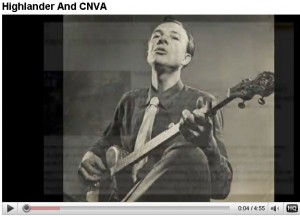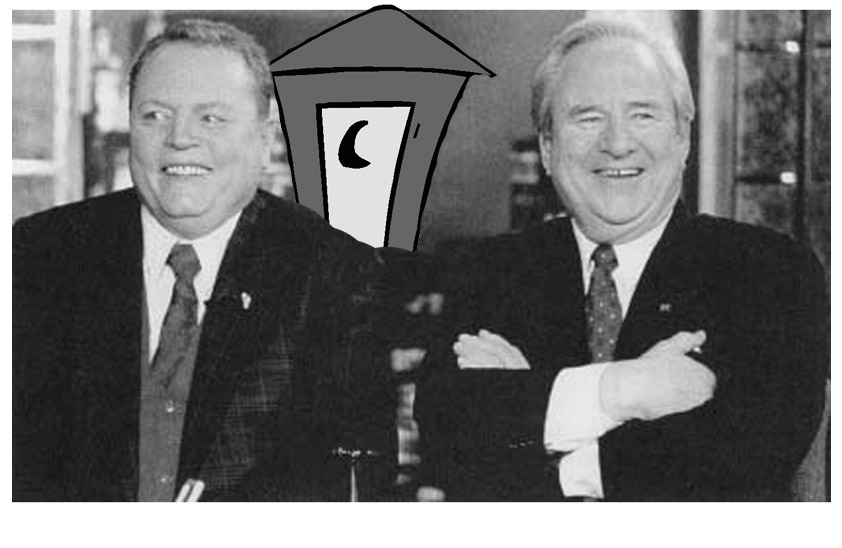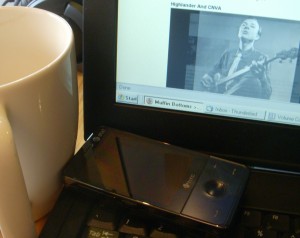1960: Attempting a Snapshot of Peace Moments in Connecticut and Tennessee.
By Marc Frucht
University Of Connecticut 4may09

Companion Video.
Committee for Nonviolent Action and the Highlander Center share so much in common throughout their distinct experiences in Connecticut and Tennessee respectively, that this essay will only attempt to survey the ideas and events around one important year in their common history; 1960.
CNVA was founded nationally in 1957 by A.J. Muste, a veteran labor agitator and Christian pacifist and David Dellinger who had been a conscientious objector since at least as early as World War II. (Brick,149) Many chapters were started around the country in the next few years, including the New England CNVA which began in 1960. Today, the New England CNVA is known as the Voluntown Peace Trust.
Highlander Folk School was established in the 1930s by Myles Horton to train labor and Civil Rights activists. Nonviolence and music were always common themes there but didn’t come into primary focus until the late 50s and early 60s. Some of this was at the inspiration of Mohandas Gandhi because he had taught non-violent direct action as a tool the people in India could use in their struggle against British rule.
Horton says the following about music in the movement:
Song, music and food are integral parts of education at Highlander. Music is one way for people to express their traditions, longings and determination. Many people have made significant contributions to music at Highlander. In the early days, Woody Guthrie and Pete Seeger came to visit. Later on, Frank Hamilton and Jack Elliott spent time with us. More recently, the Freedom Singers, Bernice Reagon and Sweet Honey in the Rock, as well as Highlander’s former codirector, Jane Sapp, have been regular contributors. There were also those who stayed at Highlander for longer periods, such as Lee Hays, one of the original Almanac Singers, and Waldemar Hille. (Horton,158)
One of the times Martin Luther King, Jr., was at Highlander, he was a keynote speaker at their seventh annual College Workshop, April 15, 1960. In this speech he called for a nationwide campaign of selective buying and said he wished for people to hold their money from places all over the south that were violent and racist.
“There is another element that must be present in our struggle that then makes our resistance and nonviolence truly meaningful. That element is reconciliation. Our ultimate end must be the creation of the beloved community.†(Adams, 154)
1960 was a very busy year for Folksinger Pete Seeger too, singing everywhere from the Nevada Test Site to protests of the Polaris submarine launchings in Groton, CT., not to mention making all the time necessary to coproduce television pilots with his wife Toshi that eventually became the weekly show Rainbow Quest on WNJU-TV in New York and New Jersey.
Marj Swann printed the following in Polaris Action Bulletin #4. 13jun60:
Four Canadian young people asked why Americans are so afraid to speak out against Government policies or to be different. At the festival, Pete Seeger, who had visited the New London office earlier, dedicated “The Hammer Song” to the Satyagraha, a sloop named after some of Gandhi’s famous nonviolent direct actions. (Swann,132)
She also credited Seeger working alongside so many other people elsewhere in the same document:
Since June 18, New London Polaris action participants have included David and Gretchen Cryer, Steve Dillingham, Erica Enzer, Charles Gardner, Art Harvey, Julius, Karl and Mimi Jacobs, Peter Kiger, Jim and Sue Lieberman, Adam Lohaus, Ken Meister, Dr., William Moser, Dr. and Mrs. Phillips Moulton and their two children, A.J. Muste, Gladney Oakley, Pete Seeger, Erica Sachs. (Swann,133)
When Seeger wasn’t singing in Connecticut, home in Upstate New York on the Hudson river, or playing a gig somewhere else in the world he was at the Highlander Folk School. (Over the years, Highlander came to be called the Highlander Research and Education Center.
Highlander was where Guy Carawan spent years teaching countless people to sing many songs, but notably “We Shall Overcome.†Nashville Public Library has a Photograph of a meeting at Fisk University, where Guy Carawan leads song on his guitar, April 21, 1960. (Gunter,1) That song was fast becoming a staple for folksingers all over America. It’s still very popular today.
So who taught Carawan to play that song? Pete Seeger of course; but who taught it to Pete? Zilphia Horton showed him the tune as her all-time favorite song when she was Highlander’s music director. Where the song originally came from and how it changed over time would easily be a good topic for anyone’s PHD thesis, because it changed so much over the decades like a well worn shoe; but Pete Seeger is credited with changing “I†to “We†and helping spread the song all over the deep south. Many consider that song to be the earliest primary link between the following movements, Abolition, Labor, Civil Rights, Peace, No-Nukes, Anti-Globalization and all points in between. Some could even argue Pete Seeger himself was that link.
Nevertheless, that song was being taught at CNVA, Highlander, and anywhere else people were discussing American social justice in 1960.
A summary of Swarthmore’s archive of College Peace papers says that
CNVA was one of the first American peace groups to “focus on nonviolent direct action including civil disobedience.†Its purpose of organizing “imaginative and dramatic protest demonstrations on both land and sea attracted radical pacifists and called the attention of the American public to the atrocities of nuclear warfare.†(Papers)
What was happening in New London County, that would call for songs, and people like Carawan, Seeger and Joan Baez to drop in often?
Polaris.
The Committee for Nonviolent Action has been concentrating its activities, since June, in New London, Connecticut — home of the Polaris submarine. The Peacemakers, late in August, chose the same town in which to hold a sixteen-day training program in nonviolent methods. I attended all sixteen days of the program. When I first learned of about it through chance, I decided to attend for perhaps a day. I had been reading Gandhi eagerly for the past year. But I expected to be unimpressed by the people I would find in New London. I assumed blandly that if they were, in fact, impressive, I should somehow have heard about them before this. (Deming, 24)
New London County is very close to New York and Boston but it’s also just a short drive from Newport. Of course that means the annual Jazz fests and Folk fests can be an easy visit for someone with a local gig; but oftentimes they would stay there at CNVA instead of booking a hotel room. And of course that made them an excellent guest teacher for a day or three.
While the members of Polaris Action were at the Newport Folk festival, they and Pete Seeger brought the project to the attention of Joan Baez, whom they had heard was a pacifist. That was the first time that Joan sang at the festival, and her extraordinarily clear, wide-ranged, powerful and moving soprano voice propelled her into the stature of perhaps the country’s premiere folk singer. (Swann,135)
Highlander was under attack by paramilitary repression as well as governmental harassment; and 1960 was not unlike many other years in Highlander’s history.
Then they arrested Guy Carawan and two other men. The charges were that Highlander was selling beer without a license and running interracial classes. (Septima [Clark] was serving Kool-Aid to high school-aged black kids from a Montgomery church group that was meeting at Highlander.) That’s the night the verse “We are not afraid” was added to “We Shall Overcome,” and it was not only the beginning of that verse, but it started the trial that resulted in the state’s confiscating Highlander’s property. (Horton,110)
CNVA was attacked in similar fashion just 8 years later while the Vietnam war was being escalated but that’s best served as topic for another discussion. Guy and his wife Candie Carawan are best known for documenting civil rights music on LP (who remembers the record album?) Many commercially released recordings and printed music anthologies have their name in production. Alas, they’d met in 1960 at Highlander! (Guy)
Not only was the song “We Shall Overcome†starting to travel all over the world, but so were many age-old concepts around Civil Rights; and perhaps some new ones.
Miles Horton says on his way to South Africa he, “had stopped off in London to visit friends, Judy and Herb Kohl. Herb and I decided to go to Belfast to talk with Tom Lovett and his family, who had previously been to Highlander for two months or so. When Tom left Highlander, he intended to go back and adapt some of the ideas he learned there to the situation in Belfast.†(Horton,221)
Meanwhile back in 1960; let’s look at CNVA some more.
“I was present at a number of these conversations,†says Barbara Deming about nonviolent training sessions in Southeastern Connecticut, “and some of them were startling to me. Many took place at C.N.V.A. headquarters — a tiny office at 13 Bank Street — where townspeople dropped in either to heckle or to ask questions; most of them were at Electric Boat, where larger and larger crowds of workers, as well as passersby, would gather after the acts of trespass. Over the months, more and more townspeople expressed sympathy, and a handful of workers volunteered to quit their jobs if the committee could find them other work.†(Deming, 27)
Deming’s book, Revolution & Equilibrium is chock full of helpful hints for Peacemakers all over the world, not just southern New England. In fact, she begins a chapter titled “The Peacemakers†with this timeless (unfortunately still pertinent!) Albert Camus quote:
A vast conspiracy of silence has spread all about us, a conspiracy accepted by those who are frightened and who rationalize their fears in order to hide them from themselves… And for all who can live only in an atmosphere of human dialogue and sociability, this silence is the end of the world… Among the powerful of today, these are the men without a kingdom… nor will they recover their kingdom until they come to know precisely what they want and proclaim it directly and boldly enough to make their words a stimulus to action. (Deming, 23)
This is a reprint from December 17, 1960’s Nation magazine, and she’s discussing people who focus on Gandhi’s way of doing much of their work behind the scenes as the years continue on along with the issues of the day; and she writes how she feels about the fact that these same people who seldom make headlines are actually doing incredibly profound things. And many of them. Nonviolent resistance, she insists, is a long-term struggle but well worth it. She died in 1984 so didn’t get to see a Barack Obama become President of the United States; or Pete Seeger for that matter, singing the complete Woody Guthrie version of “This Land Is Your Land†at his inauguration, as well as John Lewis, Joseph Lowery and so many other people who’ve remained immersed in struggle since at least as far back as 1960.
In spring, 1962 CNVA organized three simultaneous walks that began in New Hampshire, Chicago and Nashville, Tenn., all with the intention of converging on Washington, DC., on the same day there was nonviolent direct action planned at the Pentagon.
The unique aspect of this project was that the Southern walk was integrated and came during a period when violence against civil rights activists was commonplace throughout the South. The Nashville walk for peace signified to the public what had been true all along: that the nonviolent civil rights movement and the radical peace movement were two aspects of the same struggle. (Cooney,148)
Reverand James Lawson spoke the afternoon at the sendoff for the Nashville to Washington walk where he and Metz Rollins had been invited by SNCC (the Student Nonviolent Coordinating Committee.)
In the course of his talk, he remarked, “There is a clear-cut relation between the peace walk and what some of us are seeking to do in the emerging nonviolent movement in the South. Some people have tried to classify our effort here as one that is of and for and by the Negro. They have tried to define the struggle for integration as a struggle to gain the Negro more power. I maintain that it is not the case.†(Deming,104)
Nonviolence and music carry on year after year helping maintain memory within the various different aspects of the peace movement. Take a quick look what CNVA was up to in the late 1970s as well.
The call went out on February 16, 1977. Charlie King, Joanne McGloin, Joanne Sheehan, and Rick Gaumer, at the Community for Non-Violence in Voluntown, CT had evidence, from participating in the Continental Walk for Disarmament and Social Justice that others were also singing and collecting songs that gave voice to people’s struggles. The group wanted to do what came naturally — bring these folks out of the woodwork and see what happened. (Newberg)
Odetta should be mentioned as well. She may not have ever been to Connecticut or Tennessee but her songs sure have. She almost lived long enough to sing for Obama’s inauguration this year; but she died just last December not too long after saying how proud she was “that we now have a black man as president of the United States.â€
Giving voice to people’s struggles is what so many people around the United States hope the current President will do for them, but people like Odetta, Seeger, Baez and Carawan have always known it’s something we will always have to do for ourselves and for each other.
Odetta shared a stage in Washington DC back in 1998 with Seeger, Bruce Cockburn and the Indigo Girls to raise funds for both School Of Americas Watch and the Nevada Desert Experience, which brings nonviolent direct action full circle from the very first days of CNVA at the Nevada Test Site right on through the Polaris protests and on to the present with people all over the American peace movement protesting war, nuclear weapons, extraordinary rendition and the training of torture.
Pete Seeger’s 90th birthday party managed to sell out Madison Square Garden this year on Sunday May 3, 2009. Earlier in the year, Seeger also had joined his grandson Tao Rodriguez Seeger and Bruce Springsteen singing “This Land Is Your Land†at Obama’s inauguration, and he also made time to sing at Highlander Center for their 75th anniversary Sept 1, 2007. New England CNVA’s 50th anniversary is coming up next year.
Perhaps Seeger and his grandson Tao could get Cockburn, the Indigo Girls, Bruce Springsteen and so many other people to join them in singing “We Shall Overcome†at the VPT’s birthday party next year too.
Works Cited:
Adams, Frank. Unearthing Seeds of Fire: The Idea of Highlander. John F. Blair Publisher, 1975.
Brick, Howard. Age of Contradiction: American Thought and Culture in the 1960s. Ithaca: Cornell University Press, 2001.
Cooney, Robert. The Power of the People: Active Nonviolence in the United States. New Society Pub, 1987.
Deming, Barbara. Revolution & Equilibrium. Grossman, New York, 1971.
Gunter, Jack . “Photograph of mass meeting, Fisk University.” digital.library.nashville. 4 May. 2009. <http://digital.library.nashville.org/item/?CISOPTR=558&CISOROOT=%2Fnr>.
“Guy Carawan Biography.” Civil Rights Digital Library. 5 May. 2009. <http://crdl.usg.edu/voci/go/crdl/people/viewP/7005/Guy/Carawan%3Bjsessionid=F07DC50BD55A40BFD0DF13C30C6E92D2>.
Horton, Myles, and Judith Kohl, and Herbert Kohl. The Long Haul: An Autobiography. New York: Teachers College Press, 1997.
Newberg, Helene . “Homemade jam: a potpourri of regional folk activities in North America & abroad.” Sing Out Magazine. 1 Jan. 2002. 2 May. 2009. <http://www.encyclopedia.com/doc/1G1-82012502.html>.
“Papers of the New England Committee for Nonviolent Action.” Swarthmore College Peace Collection. 24 Sep. 2007. 16 May. 2009. <http://swarthmore.edu/Library/peace/DG001-025/dg017/dg017cnvane.htm>.
Swann, Marj. (Unpublished). Prospectus For a History of New England CNVA. pp. 124-143 Voluntown, CT:
Important websites:
http://www.voluntownpeacetrust.org
http://www.highlandercenter.org
This document is open source and copyleft.
It is companion to a video at:
http://www.youtube.com/watch?v=SetFVbLCPkQ&feature=channel_page






